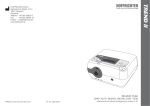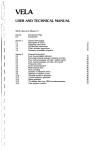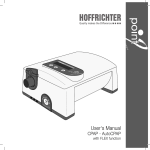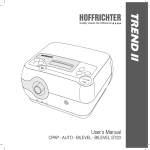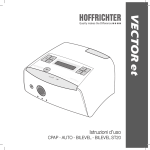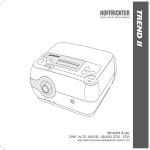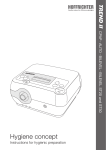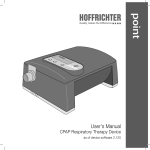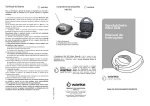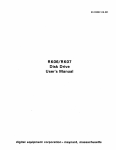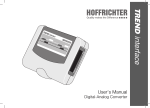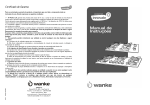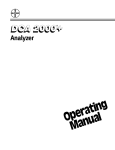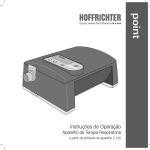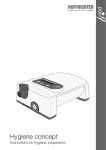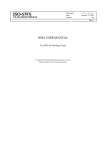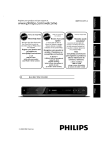Download TREND II 2.150 ENG_2015-09-02_06.indd
Transcript
Quality makes the Difference User‘s Manual CPAP - AUTO - BILEVEL - BILEVEL ST20 and ST30 TREND II 2.150 ENG_2015-09-02_06 Art.-no.: 5000 0427 as of device software 2.150 TREND II HOFFRICHTER GmbH Mettenheimer Straße 12 / 14 19061 Schwerin Germany Phone: +49 385 39925 - 0 Fax: +49 385 39925 - 25 Email: [email protected] www.hoffrichter.de TREND II User's manual ©2015 HOFFRICHTER GmbH All rights reserved. The content published in this user’s manual is the sole property of the HOFFRICHTER GmbH. All forms of reproduction, editing, distribution and any kind of exploitation, even in part, require the prior written consent of the HOFFRICHTER GmbH. The HOFFRICHTER GmbH reserves the right to amend or replace this user’s manual without prior notice. Please ensure that you are always working with the most current version of this user’s manual. Should you have any questions, please contact the ventilation device provider, or check our information at www.hoffrichter.de. The respiratory device may only be operated and maintained by trained personnel. The following documents are available for TREND II in addition to this user’s manual: • Brief instructions for physicians and medical professionals • Brief instructions for patients • Service manual • Hygiene concept SERIAL NUMBER Every HOFFRICHTER GmbH device is supplied with a serial number for traceability purposes. Please enter your device’s serial number here. You will find the serial number on the rating plate on the bottom of the device. Serial number: ..................................... Please always quote the serial number for all queries and complaints. CONFORMITY The device complies with the requirements of Directive 93/42/EEC. 4 Info CONTENTS Scope of delivery .........................................................................................7 General ........................................................................................................8 Information on user‘s manual ....................................................................8 Symbols on the packaging ........................................................................8 Symbols on the rating plate .......................................................................8 Symbols used in this user‘s manual ...........................................................9 Safety information ......................................................................................10 General safety instructions ......................................................................10 Electrical safety .......................................................................................11 Installation requirements and transport ....................................................12 Instructions before commissioning ..........................................................13 Using oxygen ..........................................................................................13 Intended use ...........................................................................................14 Contraindications ....................................................................................14 Side effects .............................................................................................15 Description of device..................................................................................16 Housing, display and control elements ....................................................16 Technical description ...............................................................................18 Power supply ..........................................................................................19 TREND II CPAP ......................................................................................20 TREND II AUTO .....................................................................................20 TREND II BILEVEL .................................................................................21 TREND II BILEVEL ST20 and ST30 .........................................................22 Using the device ........................................................................................23 Commissioning .......................................................................................23 Ending therapy........................................................................................25 Switching off the device ..........................................................................25 Standby mode ........................................................................................25 Using oxygen ..........................................................................................26 Device functions ........................................................................................28 Info-Menu ...............................................................................................29 Patient-Menu ..........................................................................................35 Clinic-Menu ............................................................................................44 Alarm functions of the device .....................................................................59 Power failure ...........................................................................................59 Mask alarm .............................................................................................59 Pressure alarm ........................................................................................60 Wake alarm .............................................................................................60 Low respiratory minute volume (only ST30) ..............................................60 Contents 5 Apnea alarm (only ST30 in mode S) .........................................................60 Using an SD card .......................................................................................61 General information .................................................................................61 Inserting the SD card ..............................................................................61 Removing the SD card ............................................................................62 What is saved on the SD card .................................................................62 Error messages .......................................................................................64 Important display messages .......................................................................66 Changing the filter cassette, cleaning .........................................................68 Changing the filter cassette .....................................................................68 Cleaning the mask ..................................................................................69 Cleaning of the therapy tube ...................................................................69 Cleaning the device .................................................................................70 Cleaning the head gear ...........................................................................70 Cleaning the humidifier ...........................................................................70 Troubleshooting .........................................................................................71 Maintenance ..............................................................................................73 Preparing the device when changing patient ............................................73 Disposal.....................................................................................................74 Device ....................................................................................................74 Packaging...............................................................................................74 Accessories ............................................................................................74 Accessories ...............................................................................................75 Technical data ............................................................................................76 Manufacturer’s declaration on electromagnetic compatibility .......................79 Disclaimer ..................................................................................................83 6 Contents SCOPE OF DELIVERY Carrying case Therapy device User’s manual Info Heiz tast e ungsEntr tast Anfe e iege uchfür lungster The ansc rapi hlus esch s lauc h- Heiz ung s-LE -Tas te D fürKon takt Anfe buc uch terhsen Mes ansc ssch hlus s lauch- Disp lay Prog ram mier tast en Filte rkas sett Eing e tast e abeon/o ff-Ta ste Brief instructions SD card (formatted) Spare filter cassette Tube plugs Mains cable Therapy tube (1.80 m) incl. measuring tube Scope of delivery 7 GENERAL INFORMATION ON USER‘S MANUAL Read this user‘s manual through carefully before using the therapy device for the first time. Follow the safety and cleaning instructions in particular. Keep the manual in a safe place close to the device so that you can refer to it immediately if necessary. SYMBOLS ON THE PACKAGING 95 Range of humidity for storage and transport 15 1060 hPa Range of ambient air pressure for storage and transport 265 hPa +70°C Range of temperature for storage and transport -20°C SYMBOLS ON THE RATING PLATE Observe the warning and safety instructions in the user‘s manual. BF application part Protection class II (protective insulation) CE conformity declaration Follow the user‘s manual. Manufacturer Do not dispose of the device in the household waste. Please contact the relevant customer services department to find out how to dispose of the device properly. 8 General SYMBOLS USED IN THIS USER‘S MANUAL Important information is denoted by symbols in this user‘s manual. Be sure to follow these instructions in order to avoid accidents, personal injury and material damage. In addition, the local accident prevention regulations and general safety regulations in force in the area of use must be observed. This symbol denotes general safety instructions. Follow these instructions to avoid accidents, personal injury or material damage. This symbol denotes hazardous situations that lead to serious injuries or death. This symbol denotes hazardous situations that may lead to serious injuries or death. This symbol denotes hazardous situations that may lead to moderately severe injuries. This symbol denotes situations that may lead to material damage or damage to the device. This symbol denotes information, tips and instructions for the efficient, error-free use of the device. General 9 SAFETY INFORMATION GENERAL SAFETY INSTRUCTIONS • The device must only be used for your own CPAP therapy, which is prescribed by the physician. • Use only accessories and spare parts tested and approved by the manufacturer. • For operation and usage of the device at home, a respiratory mask specially adapted for the individual patient is required in addition to the therapy device with power cable and therapy tubing system. Only use masks that have been prescribed for your treatment by a physician. • Only use the mask together with a respiratory therapy device and when the device is switched on. • Unless specified otherwise, the mask and therapy tube must only be used by one patient. • Only use the mask after instruction by a qualified medical person and clarify in particular the intake of medicines and possible contraindications and side effects associated with the use of the mask. • If you are using oxygen with the CPAP therapy, observe the fire protection and safety regulations for using oxygen. • Do not wear the mask if the therapy device is switched off because this could lead to breathing in air that has already been exhaled. Observe the respiratory mask manufacturer’s instructions. • Always ensure that the small hole in the mask or in the adapter between the mask and the tube is unobstructed so that the exhaled air that is loaded with CO2 can escape. • Observe the mask manufacturer‘s instructions. • Please see your physician immediately if dryness of the mucous membranes in the nose and throat, sinus discomfort, ear ache, runny nose, over sensitive reactions of the skin, irritability, loss of voice, orientation or memory impairment occur when using the device. • Inform your specialist dealer immediately if the device is not working properly. • Check the device’s alarm functions regularly (see page 59). 10 Safety information ELECTRICAL SAFETY • Do not use the device if the housing or the cable of the device or the power supply are damaged. • Always remove the power plug before cleaning. • Do not open the device housing under any circumstances. Inform your specialist dealer if the device develops a fault. • The use of accessories or power supplies not approved by us for the device may lead to increased emission of electromagnetic radiation or reduced resistence to interference. • Protect the device from water and dampness. • Never operate the device in damp places or in a bathroom. • Do not put any containers full of liquid on the device. • Do not reach for the device under any circumstances should it fall into water. Immediately unplug the power plug. • Do not put the device near water containers (baths). Safety information 11 INSTALLATION REQUIREMENTS AND TRANSPORT • Place the device near the bed. Ideally a firm, level surface on your bedside cabinet is suitable. • Never put the device on a cupboard shelf or under the bed. • Do not put the device with its back to a wall. Ensure that the air inlet is not covered. • Ensure that the device is in a horizontal position, especially if it is connected to a humidifier. • Ensure that the air can circulate properly round the device. Air circulation, particularly under and behind the device, must not be obstructed by furniture, curtains or cushions. • Place the device in such a way that the mains plug is easily accessible so that it can be unplugged quickly in the event of a hazard. • Do not put the device close to a source of heat. • Place the device and accessories in such a position that they are not exposed to direct sunlight. • The device must never be put near other devices or equipment such as defibrillators, diathermy units, mobile phones, microwaves, remote controlled toys, etc. Electromagnetic fields that exceed 3 V/m may adversely affect the operation of the TREND II. • When used as a mobile unit, it must also be placed on a level, firm surface that has a raised edge so that the device cannot fall. • During mobile use of the device, only operate it when the vehicle is stationary. 12 Safety information INSTRUCTIONS BEFORE COMMISSIONING • Do not switch the device on if it has previously been in a very cold environment. Wait about 1 hour until the temperature has balanced out. • Check the filter cassette regularly. Change the filter cassette as described on page 68. Never use the device without the filter cassette. • Clean your mask system regularly and check all accessories, particularly the therapy tube, mask and headgear. When doing this, observe the manufacturer’s safety and cleaning instructions. USING OXYGEN • Oxygen supports combustion. Therefore, observe the fire protection regulations applicable for using oxygen. • Ensure that there is no grease on the oxygen fittings. Do not smoke and do not handle naked flames. • Before the device is used, appropriate training must be carried out in the home environment. • Please be sure to observe the user’s manual of the manufacturer or distributor from whom you obtain the oxygen. • Make sure that the distance between the oxygen source and device is at least 1 m. • Have your distributor advise you about the use of oxygen. • In any case, follow your physician’s instructions. Safety information 13 INTENDED USE The TREND II is used to treat obstructive sleep apnea in patients weighing more than 30 kg. The device creates continuous, positive airway pressure to keep the upper respiratory tracts open. The device is not suitable for use with patients undergoing artificial respiration. This therapy device is not a life-supporting system. The therapy pressure is administered via a respiratory mask which must be fitted with an exhalation valve to ensure that the exhaled air is discharged. If an AquaTREND uni humidifier is connected to the device, the water in the humidifier must not contain any additives such as medicines, salts, aromatic oils or other substances. CONTRAINDICATIONS Respiratory therapy may be contraindicated for certain pre-existing conditions. Therefore, always talk to the physician treating you before starting the therapy. Pre-existing conditions include: • bullous lung diseases • pneumothorax • very low blood pressure • pneumocephalus after open craniocerebral injury or other head injuries In the event of inflammation of the paranasal sinuses or a middle-ear infection, it should be checked whether the therapy can continue. Please speak to your physician about this. 14 Safety information SIDE EFFECTS There is the possibility of undesirable side effects occurring with respiratory therapy. Reasons for side effects occurring could be unsuitable therapy settings, not using the device properly or not following the cleaning instructions. Normally the side effects disappear when the causes have been eliminated. You will find suitable counter measures for some side effects in the section “Troubleshooting” on page 71. The following side effects may occur during therapy: • Pain in the nose, the paranasal sinuses and the ears • Dryness and irritation in the nose and throat • Nose bleed, runny nose, sneezing, colds • Irritated or dry eyes • Reddening of the skin, swelling of the skin and pressure points in the mask area • Difficulty breathing, claustrophobia • Stomach problems because of air accumulating in the stomach Please contact your physician for an explanation of the causes should these complaints persist. Safety information 15 DESCRIPTION OF DEVICE HOUSING, DISPLAY AND CONTROL ELEMENTS Programming keys Heater LED Info key Display Filter cassette Heater key Unlocking button for humidifier Enter key on/off key Connection for therapy tube Contact socket for humidifier Connection for measuring tube 16 Description of device Air inlet Power connection 24 V DC RS232 interface Power connection 100...240 V AC SD card slot SD card slot Description of device 17 TECHNICAL DESCRIPTION For all devices of the TREND II series the following characteristics apply: To generate the necessary pressure, the device Air inlet is provided with an electronically controlled blower. In order to keep the stress for the patient as low as possible, the blower has Filter been designed with a high reserve capacity and a quick control response. Control unit The pressure is measured directly in the mask and constantly controlled by the device. Consequently, the breathing work for the patient is as easy as possible. There are two separate tubings in the device. One is for respiratory air and one is for the convection air required for cooling the electronics. The device contains a built-in microcontroller which controls all of its functions. Blower Pressure sensor A quartz alarm clock further adds to the comfort when using the device. Further comfort functions include a soft start ramp, the automatic start-stop function and the adjustable display brightness. While passing through the Air outlet device, the air is heated a little, so that it has Connector a higher water absorbency. When indoor air measuring is dry in winter, the mucous membranes in tube mouth and nose may become particularly dry. This is unpleasant and may even cause infections in exceptional cases. For that reason, a therapy might require air humidification. AquaTREND uni a clip-on humidifier is available as accessory for all TREND II devices. If necessary, just click the humidifier onto the device. Remove it by pressing its release button. The heater levels are set in the heater menu. The selected heater level is displayed as in the display of the device while the humidifier heating is switched on. .!00EH !/ L = =<L?@ For more information please see your AquaTREND uni - User`s manual or contact your specialized dealer. 18 Description of device POWER SUPPLY Internal switched-mode power supply For mains operation the TREND II has an internal switching power supply with a wide input range of 100 - 240 V alternating current (AC), 50 - 60 Hz. Thus it is possible to connect it to an energy supply anywhere in the world. . DC vehicle cable For mobile use of the TREND II, e.g., in a truck or a caravan, it is possible to operate it with a 24 V direct current (DC). For this you will need the optionally available DC vehicle cable. Only use the optional DC vehicle cable to connect the device to a DC power supply and do not connect the device to a PC while it is being used. Description of device 19 TREND II CPAP The CPAP device is a therapy device for treating obstructive sleep apnea. For this purpose the device provides a continuous positive air pressure. Apart from the conventional CPAP-mode the device offers a proportional increase in pressure in the FLEX mode to the individual breath flow during inspiration and a pressure drop during the expiration. This intelligent method of pressure adjustment makes a careful therapy possible. TREND II AUTO Within a certain pressure range the device automatically controls the therapy pressure depending on the occurrence of respiratory events (APAP = Adaptive Positive Airway Pressure). In sleep phases with no events the therapy pressure is lowered. Starting obstructive events are treated effectively with a slight pressure increase. For a high therapy comfort the therapy pressure should always be only as high as necessary and as low as possible. The device can recognize the following respiratory events: • Obstructive apnea • Hypopnea • Central apnea • Snoring • Normal respiration • Increased airway resistance The identification of the different respiratory events is achieved via 3 channels: 1. Measurement of any constriction of the respiratory tract 2. Detection of flow limitations by measuring the flow 3. Detection of snoring with the help of sound detection The combined analysis of all results facilitates a very precise differentiation between obstructive and central events. The device adjusts the therapy pressure according to the detected events as described below: • Increase of pressure for obstructive events • Decrease of pressure for central events and normal respiration In addition, the pressure increase can be adjusted in 5 levels according to special requirements and to the individual patient comfort. These settings are performed by the physician with the help of the PC software TRENDset. The TREND II AUTO offers a CPAP, APAP and FLEX mode. For APAP and FLEX mode, a pressure increase for inspiration and a pressure decrease for expiration can be set. Both pressure increase and decrease are following the individual 20 Description of device respiration flow proportionately. This intelligent method of pressure adjustment facilitates a careful therapy. TREND II BILEVEL The device has two different adjustable pressure levels. A higher level for inspiration and a lower level for expiration. Trigger device The respiration trigger detects the patients efforts to breath in and out and signals these efforts to the control device. A volume-based trigger can be set for inspiration, and a flow-based trigger for expiration. In conjunction with an optimum slope adjustment, this results in a therapy which is very comfortable for the patient and which gives the impression as if the device is following the natural respiration without any delay. During the expiration phase a negative pressure (vacuum) will not be created. CPAP-mode The device provides continuous positive pressure for the therapy. S-mode Spontaneous trigger – the change from one pressure level to another is triggered by starting respiration of the patient only. When the inspiration flow ends, the pressure drops to the lower level set. In addition, a backup frequency (Backup freq) can be activated so that in the event of apnea, the patient continues to be ventilated with fixed parameters. Description of device 21 TREND II BILEVEL ST20 AND ST30 The device has two different adjustable pressure levels. A higher level for inspiration and a lower level for expiration. Trigger device The respiration trigger detects the patients efforts to breath in and out and signals these efforts to the control device. A volume-based trigger can be set for inspiration, and a flow-based trigger for expiration. In conjunction with an optimum slope adjustment, this results in a therapy which is very comfortable for the patient and which gives the impression as if the device is following the natural respiration without any delay. The modes CPAP, S, ST and T are integrated in the device. CPAP-mode The device provides continuous positive pressure for the therapy. S-mode Spontaneous trigger – the change from one pressure level to another is triggered by starting respiration of the patient only. When the inspiration flow ends, the pressure drops to the lower level set. In addition, a backup frequency (Backup freq) can be activated so that in the event of apnea, the patient continues to be ventilated with fixed parameters. ST-mode Spontaneous breathing and Timed – as long as the patient is breathing spontaneously the device is operating in the S-mode. If the patient stops breathing, the device automatically switches to the T mode and ventilates the patient with the set frequency. The delay time after which the device switches into the T-mode is adjustable. T-mode Timed respiration with prescribed, set inspiration time. If the trigger function is deactivated the patient is ventilated according to the set parameters. If the trigger function is activated the device accepts only spontaneous trigger signals in the expiration phase. During the expiration phase a negative pressure (vacuum) will not be created. 22 Description of device USING THE DEVICE COMMISSIONING Before commissioning the device, read the section “Safety information” (from page 10). The device must not be operated without a filter cassette because this could damage your health. 1. After having set up the device properly, connect the device using the supplied power cord, with the socket outlet. 2. The device displays a welcoming message, the software version and the current number of treatment hours. Thereafter, the display shows the date and time. 3. Connect the therapy tube to the air outlet. 4. Connect the therapy tube to the mask. Using the device 23 5. Also connect the measuring tube to the measuring tube connection. 6. Put on the mask. If you have selected the automatic mode, the device will start on your first breath. In the manual mode, press the on/off key to start the device. 7. The device first of all runs at maximum pressure for the time selected by you for the mask test. You should now properly seat the mask in order to eliminate any potential leaks. 8. Place the tube such that it does not exert any pulling action on the mask while you are lying down 9. Breathe deeply and calmly. If you have activated the soft start function, the device initially reduces the pressure after completion of the mask test and will then slowly increase the pressure automatically to the prescribed value, allowing you to fall asleep at a lower pressure. In the section “Device functions” (from page 28) read how you can adapt the times for soft start and the mask test to suit your personal requirements. 24 Using the device ENDING THERAPY To end the therapy, press the on/off key. If you are using an SD card, the therapy data is saved on the SD card after the therapy is ended. During this time, the message “Do not remove the SD card” is shown on the display. + *+/ .!)+2! /$! . On no account remove the SD card during saving. This could lead to loss of data or damage to the SD card. SWITCHING OFF THE DEVICE Ensure that the device is in standby mode. Then unplug the power plug. STANDBY MODE If the turbine is switched off, the device switches to standby mode (discernable on the display with date and time). .!00EH =@ 5 << <=L =; The TREND II can be kept in standby mode permanently. This does not harm it. Using the device 25 USING OXYGEN If oxygen is using the therapy setting must be set, that no backflow of oxygen takes place into the device. Before using oxygen, it is essential to read the safety information on page 13. When supplying oxygen, please use a kink-resistant tube made of a medically approved material. In order to prevent back flow of oxygen into the device, we recommend the use of an O2 pessure valve. There are two variants to supply oxygen. Variant 1: Supplying oxygen directly in the mask Mask O2 source O2 pressure valve Therapy tube Variant 2: Supplying oxygen via an adapter between therapy tube and O2 pressure valve O2 pressure valve Mask O2 source Therapy tube O2 supply adapter The O2 supply adapter and O2 pressure valve you can order as accessory (see page 75). 26 Using the device Proceed as follows when using oxygen: If the device is in standby mode or switched off, the oxygen supply must always be switched off. 1. Before starting the treatment, check that the tube connections are fitted correctly. 2. First of all, switch the device on and then the oxygen supply. 3. Check whether the “Auto off” automatic mode is active. If not, program it as described on page 41. 4. Switch off the oxygen supply before switching the device off. Using oxygen influences the therapy pressure. Therefore we recommend to inclose oxygen in the therapy pressure determination / titration process, for every patient who‘s therapy is intended to include an oxygen supply. Using the device 27 DEVICE FUNCTIONS There are three keys for programming the TREND II functions. = Programming key = Programming key = Enter key The display has two lines. Using the programming keys and , you can select the line to be displayed. The triangular symbol> preceding the line indicates that this line has been selected. Q.!00MMMMMMB @$ 4%/!*1 Example: Pressure If you do not press any key for 30 seconds while programming, the programming mode is automatically exited for safety reasons. Unless the changed value is confirmed with the enter key when the programming mode is exited, the original value remains as it is. If you select the line Exit Menu and then press the enter key , programming is ended. The device has three different menus: 1. Info-Menu In this menu the set parameters can be displayed. 2. Patient-Menu In this menu the patient can change settings. 3. Clinic-Menu In this menu, only a physician or service technicians can change settings. Use the programming key for scrolling within the menus. The sequence of the menu structure is shown in the table from page 29. 28 Device functions INFO-MENU By pressing the info key i you get to the Info-Menu. By pressing the progaming keys and you can see the next parameters. For the parameters “Use”, “AI” or “AHI” and “Leak”, pressing the enter key enables you to display average values across different periods of time. To exit the Info-Menu select the line Exit Menu and then press the enter key . If you do not press any keys for 30 seconds the device will automatically switch back to the operating mode. The following table shows which parameters are displayed in the Info menu, depending on the set mode or device type. Mode APAP BILEVEL S CPAP FLEX BILEVEL ST BILEVEL T • • • • • • • • • • • • • • • • • • Therapy • • • • • • Filter • • • • • • Ramp • • • • • • Parameter Use[D] Use[W] Use[M] Use[6M] Use[Y] AI[D]1 AI[W]1 AI[M]1 AI[6M]1 AI[Y]1 Leak[D] Leak[W] Leak[M] Leak[6M] Leak[Y] P-Ramp • • • • • • Mode • • • • • • Press. • • - - - • • • • • • P-Start - • - - - P-Min - • - - - P-Max - - - - I-Pres. E-Pres. • - - - I-FLEX - • • - - - E-FLEX - • • - - - I-Slope - - - • • • Device functions 29 Parameter E-Slope CPAP FLEX - - Trigger - I-Trigger - E-Trigger - Frequency - Backup freq - I:E Delay Time VT min P-addit. TI min TI max Low MV2 Apnea2 - Mode APAP BILEVEL S • - - BILEVEL ST • BILEVEL T • - - • • • •4 • • - - • • • - - - • • •3 •5 •6 •6 •3 - • •3 •5 •6 •6 •3 • 3, 7 •3 •5 •3 - Next parameter is displayed by pressing the enter key 1 234567 1 2 3 4 5 6 7 30 in TREND II CPAP and TREND II AUTO “AHI“ (Apnea-Hypopnea-Index) instead of “AI” is displayed only available when activated by physician only TREND II BILEVEL ST30 only if trigger is “ON” cannot be set if VT min is “OFF” only TREND II BILEVEL ST20 and ST30 only if Backup frequency is “OFF” Device functions MEANING OF THE PARAMETERS IN THE INFO MENU Q0!MMMMMMMMMMC;$ 4%/!*1 Use[D] Shows the average operating time of the last therapy day1 Q0!MMMMMMMMMMB@$ 4%/!*1 Use[W] Shows the average operating time, per therapy day, in the last week Q0!MMMMMMMMMMC;$ 4%/!*1 Use[M] Shows the average operating time, per therapy day1, in the last month Q0!AMMMMMMMMC@$ 4%/!*1 Use[6M] Shows the total operating time, per therapy day1, in the last 6 months Q0!MMMMMMMMMMC@$ 4%/!*1 Use[Y] Shows the average operating time, per therapy day1, in the last year Q MMMMMMMMMMMMD= 4%/!*1 AI[D] Shows the apnea index of the last night Q MMMMMMMMMMMMMM@D 4%/!*1 AI[W]2 Shows the apnea index of the last week Q MMMMMMMMMMMMMMA@ 4%/!*1 AI[M]2 Shows the apnea index of the last month Q AMMMMMMMMMMMMAC 4%/!*1 AI[6M]2 Shows the apnea index of the last 6 months Q MMMMMMMMMMMMMMA? 4%/!*1 AI[Y]2 Shows the apnea index of the last year 1 from 12.00 to 12.00 o’clock 2 in TREND II CPAP and TREND II AUTO “AHI” (Apnea-Hypopnea-Index) instead of “AI” is displayed Device functions 31 Q!'MMMMMMMMMMMM@N 4%/!*1 Leak[D] Shows the percentage of the operating time in which increased leakage was detected, over the period of the last therapy day1 Q!'MMMMMMMMMMMM=N 4%/!*1 Leak[W] Shows the percentage of the operating time in which increased leakage was detected, over the period of the last week Q!'MMMMMMMMMMMM?N 4%/!*1 Leak[M] Shows the percentage of the operating time in which increased leakage was detected, over the period of the last month Q!'AMMMMMMMMMM>N 4%/!*1 Leak[6M] Shows the percentage of the operating time in which increased leakage was detected, over the period of the last 6 months Q!'MMMMMMMMMMMM>N 4%/!*1 Leak[Y] Shows the percentage of the operating time in which increased leakage was detected, over the period of the last year Q$!.,5MMMMMMMM<=>$ 4%/!*1 Therapy Shows the total therapy time of the device Q%(/!.MMMMMMMMMM<=>$ 4%/!*1 Filter Shows the time since the last filter change Q),MMMMMMMMMMMM@;)%* 4%/!*1 Ramp Shows the remaining time of the soft start ramp Q ),MMMMMM? @$ 4%/!*1 P-Ramp Shows the ramp start pressure Q+ !MMMMMM%(!2 4%/!*1 Mode Shows the selected mode 1 from 12.00 to 12.00 o’clock 32 Device functions Q.!00MMMMMMB @$ 4%/!*1 Press. (only in modes CPAP and FLEX) Shows the selected therapy pressure Q /./MMMMB @$ 4%/!*1 P-Start (only in mode APAP) Shows the selected start pressure Q % *MMMMMMMM@ ;$ 4%/!*1 P-Min (only in mode APAP) Shows the selected minimum pressure Q 4MMMMMM<; ;$ 4%/!*1 P-Max (only in mode APAP) Shows the selected maximum pressure QMMMMMMMMMMMMMMM> 4%/!*1 I-FLEX-Level (only in modes APAP and FLEX) Shows the selected I-FLEX-Level QMMMMMMMMMMMMMMMM> 4%/!*1 E-FLEX-Level (only in modes APAP and FLEX) Shows the selected E-FLEX-Level Q .!0 MM<; ;$ 4%/!*1 I-Pres. (only in modes S, T and ST) Shows the selected inspiration pressure Q.!0 MMMMA ;$ 4%/!*1 E-Pres. (only in modes S, T and ST) Shows the selected expiration pressure Q(+,!MMMMMMMMMMMM>0 4%/!*1 I-Slope (only in modes S, T and ST) Shows the selected inspiration slope Q(+,!MMMMMMMMMMMM>0 4%/!*1 E-Slope (only in modes S, T and ST) Shows the selected expiration slope Q.%##!.MMMMMMMMMM 4%/!*1 Trigger (only in mode T) Shows if the inspiration trigger is activated or not Q .%##!.MMMMMMMMMM= 4%/!*1 I-Trigger (only in modes S, T and ST) Shows the selected inspiration trigger threshold Q .%##!.MMMMMMMMMM= 4%/!*1 E-Trigger (only in modes S and ST) Shows the selected expiration trigger threshold Device functions 33 Q.!-1!*5MM<=,) 4%/!*1 Frequency (only in modes T and ST) Shows the selected number of breaths per minute Q!(5%)!MMMMMM>0 4%/!*1 Delay Time (only in mode ST) Shows the delay for switching from S-mode to T-mode Q'1,".!-MMMM 4%/!*1 Q L MMMM<L =M <<A0 4%/!*1 Q )%*MMMMMMMM=;;)( 4%/!*1 Q %/ MM> ;$ 4%/!*1 Backup freq (only in mode S in TREND II BILEVEL, BILEVEL ST20 and ST30) Shows whether the backup frequency is switched on or not I:E (only in modes T and ST) Shows the inspiration duration and the ratio of inspiration to expiration VT min (only ST30 in mode ST) Shows the target volume per breath P-addit. (only ST30 in mode ST) Shows the pressure that is added in order to reach the target volume Q)%*MMMMMMMMMM<=0 4%/!*1 TI min (only ST30 in modes S and ST) Shows the minimum inspiration time Q)4MMMMMMMMMM>;0 4%/!*1 TI max (only ST30 in modes S and ST) Shows the maximum inspiration time Q +3MMMMMMMM 4%/!*1 Q,*!MMMMMMMMMM 4%/!*1 34 Device functions Low MV (only ST30 in modes S, T and ST) Shows whether the alarm for too low respiratory minute volume “Low MV” is active or deactivated Apnea (only ST30 in mode S, if backup frequency “OFF”) Shows whether the “Apnea” alarm is active or deactivated PATIENT-MENU Press and hold the enter key (at least 1 second) to move to the programming mode. The Patient-Menu will now appear on the display. The following table shows which parameters can be set in the Patient-menu, depending on the device type. Device CPAP AUTO BILEVEL BILEVEL ST20 BILEVEL ST30 Wake Time • • • • • Delete Filter • • • • • Mask - • - - - Parameter Ramp • • • • • Mask Test • • • • • Auto • • • • • Display Vt • • • • • Brightness • • • • • Date • • • • • Time • • • • • Device functions 35 SETTING PARAMETERS AND THEIR MEANING Wake Time >Wake Ti me..07:00 Exit Menu The wake time can be set or changed here. To set the wake time, first go to the Patient-menu (hold down the enter key for approx. 1 second). Pressing the enter key causes the wake hour to flash. It can now be changed using the programming keys and . After pressing the enter key again the minute of the wake time will start flashing. Now you can change it using the programming keys and . Pressing the enter key again ends the input and you get back to the menu. Changing the wake time will automatically activate the alarm clock. After leaving the menu the alarm clock can be activated and deactivated with the help of the programming keys and . Press programming key to activate the alarm function. The display briefly shows the wake up time allowing you to verify it. .!00EH (.) ;BL;; After that a bell symbol in front of the time display shows that the wake alarm function is activated. .!00EH =@ 5 << <=L =; Press the programming key to deactivate the wake alarm function. The bell symbol disappears. .!00EH (.)(+' Delete Filter Q!(!/! %(/!. 4%/!*1 In this menu item the filter counter can be reset. This function should be used at every filter change so that always a current value is displayed. To reset the filter counter, go to the Patient-Menu (press the enter key key for approx. 1 second), then select Delete Filter with the programming keys and . Press the enter key . The system will now ask you whether you are sure that you want to perform a reset. 36 Device functions Press the enter key to perform the reset. Now the filter counter is reset to zero. If you do not want to reset the filter counter, leave the menu using the programming keys and or wait until the system leaves the menu item automatically. Mask (only in mode APAP in TREND II AUTO) Q0'MMMMMMMMMMMMMM+0! 4%/!*1 In this menu item the type of mask can be chosen. This is important for the correct function of the therapy device. You can choose between Nose and Nose/Mouth: • Choose Nose for all nasal masks and pillow masks. • Choose Nose/Mouth for all nasal/mouth masks. To select the type of mask, first go to the Patient-menu (hold down the enter key for approx. 1 second). Then select Mask using the programming keys and and press the enter key to change the setting. Ramp Q),MMMMMMMMMMMM@;)%* 4%/!*1 Whenever the blower has been started, the microcontroller of the device checks whether a soft start ramp has been programmed. While the programmed time elapses, the soft start function increases the pressure from an adjustable initial ramp pressure (P-Ramp) up to the pressure prescribed, thus allowing you to fall asleep more easily. In particular if you are not yet used to the respiration therapy the soft start can help you get accustomed to the device and fall asleep easily. The device allows delay times ranging from zero (the prescribed therapy pressure is applied at once) to 60 minutes (the prescribed therapy pressure is built up within 60 minutes). The initial ramp pressure (P-Ramp) can be set by health professionals within a range from 4 hPa to the pressure prescribed. To set the ramp, first go to the Patient-Menu (press the enter key for approx. 1 second), then select Ramp with the programming keys and . Press the enter key . Now select the desired time using the programming keys and . Press enter key to confirm. Device functions 37 CPAP, FLEX and APAP The pressure is gradually increased up to the therapeutic pressure. BILEVEL S, ST and T The pressures are gradually increased up to the therapeutic pressures. I-Pressure E-Pressure 38 Device functions Mask Test Q0'!0/MMMMMM>;0 4%/!*1 This parameter determines the time when the device performs a mask test. To ensure that the mask is tight while the pressure slowly increases in the soft start ramp even with higher pressures, you can program a mask testing time from 5 to 90 seconds in 5-second intervals. This mask test is carried out before the ramp is started. It checks whether the mask is tight even under the maximum therapy pressure. The following table shows for every model, how the pressure during mask test is calculated subject to the mode that has been set. CPAP FLEX TREND II CPAP Press. TREND II AUTO Press. Press. + I-FLEX Press. + I-FLEX Device Mode APAP BILEVEL BILEVEL BILEVEL S ST T - - - - P-Max + I-FLEX - - - TREND II BILEVEL Press. - - I-Pres. - - TREND II BILEVEL ST20 Press. - - I-Pres. I-Pres. I-Pres. TREND II BILEVEL ST30 Press. - - I-Pres. + P-addit. I-Pres. + P-addit. I-Pres. + P-addit. To set the mask test, first go to the Patient-Menu (press the enter key for approx. 1 second), then select Mask Test with the programming keys and . Press the enter key . Now select the desired time using the programming keys and . Press to confirm. Device functions 39 CPAP, FLEX and APAP The pressure is gradually increased up to the therapeutic pressure. Mask Test BILEVEL S, ST and T Mask Test The pressures are gradually increased up to the therapeutic pressures. I-Pressure E-Pressure 40 Device functions Auto The automatic mode provides three settings (OFF, Start/Stop, Start): 1. Auto OFF (with mask alarm) Q1/+MMMMMMMMMMMMMMMM 4%/!*1 If you set “Auto OFF” the device must be turned on in the evening and turned off in the morning with the on/off key. If the mask slips off your face or a leak occurs while you are asleep, a visual and audible warning is emitted (mask alarm). 0'(.)MMMMMM<;0 $!'0'H 2. Auto Start / Stop Q1/+MM/./E/+, 4%/!*1 If you set “Auto Start/Stop”, you must simply put the mask on your face. 1/+*0'H =@ 5 << ==L <@ Once you start breathing, the turbine of the device is turned on. If you take the mask off, the turbine is automatically turned off after a delay time of 5 seconds. In the automatic mode, the turbine is turned off even if the mask or the tube slips off unnoticed during the night. 3. Auto Start (with mask alarm) The third option that can be selected is the “Auto Start” mode. Q1/+MMMMMMMMMMMM/./ 4%/!*1 Once you start breathing, the turbine of the device is turned on. If the mask slips off your face or a leak occurs while you are asleep, a visual and audible warning is emitted (mask alarm). 0'(.)MMMMMM<;0 $!'0'H However, the turbine is not switched off. It can only be switched off by pressing the on/off key. Device functions 41 The automatic function can be deactivated in the TREND II BILEVEL ST20 and ST30 with the PC software from the medical staff. The device can be switched on or off in every mode by pressing the on/ off key. To set the automatic function, first go to the Patient-menu (hold down the enter key for approx. 1 second). Then select Auto using the programming keys and . Press the enter key to change the setting. Display Vt Q%0,(5/MMMMMM 4%/!*1 Here, you can set whether the tidal volume and the respiratory status (S=spontaneous, T=timed [only in ST mode, and in S mode when Backup frequency is “ON”]) are displayed during therapy. To activate or deactivate the display of the tidal volume, first go to the PatientMenu (press the enter key for approx. 1 second). Then select Display Vt using the programming keys and and press the enter key to set the desired setting (“ON” or “OFF”). The display of the tidal volume during the therapy replaces the display of the date. The alarm clock is still active. Brightness Q.%#$/*!00MM<;;N 4%/!*1 In this menu item you can set the brightness of the display. To set the brightness of the display, first go to the Patient-menu (hold down the enter key for approx. 1 second). Then select Brightness using the programming keys and . After pressing the enter key the currently set brightness will flash and can then be adjusted using the programming keys and in intervals of 10 %. Press enter key for accepting the selected brightness. If no key is pressed for 30 seconds the device will reset the brightness to the old value. After pressing any key the brightness of the display will automatically switch to 100 % for better visibility. 42 Device functions Date Q/!MMMM=@ 5 << 4%/!*1 Use this menu item to set the date. To set the date, first go to the Patient-menu (hold down the enter key for approx. 1 second). Then select Date using the programming keys and . After using the enter key the year will flash and can be set using the programming keys and . After using the enter key again the month will flash and can be set using the programming keys and . After using the enter key again the day will flash and can be set using the programming keys and . Press the enter key again to accept the set date. Time Q%)!MMMMMMMMMMMM<>L;; 4%/!*1 Use this menu item to set the time. To set the time, first go to the Patient-menu (hold down the enter key for approx. 1 second). Then select Time using the programming keys and . After pressing the enter key the hour will flash and can be set using the programming keys and . After pressing the enter key again the minutes will flash and can be set using the programming keys and . Press the enter key again to accept the set time. With its built-in battery, the internal clock has a reserve power of 8 years without connection to the external power supply. Device functions 43 CLINIC-MENU In addition to the parameters in the Clinic-Menu, in the Clinic-Menu parameters relevant for the therapy can be set. This menu is used only by health and service professionals. Some parameters are protected by a PIN code in order to prevent incorrect parameters being entered. Please do not try to find out the PIN. If you are in doubt as to whether the set parameters are correct, please consult your physician. The following table shows which parameters can be set in the Clinic-menu, depending on the device type. Parameter Mode1 Press.1 P-Start1 P-Min1 P-Max1 I-FLEX1 E-FLEX1 Mask I-Pres.1 E-Pres.1 I-Slope1 E-Slope1 Trigger1 I-Trigger1 E-Trigger1 FLEX • • • • - - • - • - Frequency1 I:E1 Delay Time1 Backup freq1 VT min1 P-addit.1 TI min1 TI max1 Ramp P-Ramp Mask Test Auto Display Vt 44 Mode APAP BILEVEL S • • - CPAP Device functions BILEVEL ST • - BILEVEL T • - - - - • - - - - • - - - - - - • • • - - - - - • - - - • • •2 - - - - • - - - • - • • - - - - •5 •5 •5 - - - •3 •3 - • • • • • • • • • • • • • • • • • • • • • • • • Parameter Low MV1 Apnea1, 4 Brightness Language P-Unit Turbine Filter Therapy Standby Delete Filter Date Time Wake Time 12 Mode APAP BILEVEL S CPAP FLEX BILEVEL ST BILEVEL T - - - •5 •5 •5 • • • • • • • • • • • • • • • • • • • • • • • • • • • • • • • • • • • • • • • • • • • • • • • • Next parameter is displayed by pressing the enter key 3 45 1 To prevent incorrect parameters being entered, it is necessary to enter a PIN. This PIN is known to your physician and specialist dealer 2 E-Trigger not in T mode, I-Trigger only if trigger is “ON” 3 only TREND II BILEVEL ST20 and ST30 4 Apnea only in mode S, if Backup frequency is “OFF” 5 only TREND II BILEVEL ST30 Device functions 45 THERAPY-RELEVANT PARAMETERS AND THEIR MEANING Mode Q+ !MMMMMM%(!2 4%/!*1 The devices can be operated in different modes. The following table shows which modes are available for your device. Mode CPAP FLEX • • • • • • • - Device type TREND II CPAP TREND II AUTO TREND II BILEVEL TREND II BILEVEL ST20 TREND II BILEVEL ST30 APAP BILEVEL BILEVEL BILEVEL S ST T • - • • • • • • • To set the mode, first go to the Clinic-menu. Then select Mode using the programming keys and . Press the enter key . Now the device will prompt you to enter the PIN. Q + !G 4%/!*1 ;;;; The first digit is flashing. Enter the first digit of the PIN with the help of the programming keys and . After pressing the enter key the second digit will flash. Enter the second digit of the PIN with the help of the programming keys and , and proceed as described for the first digit. Enter the third digit accordingly. After entering the last digit of the PIN you can switch between the modes by pressing the enter key . Leave the menu once the desired mode is selected. The device will then save the new mode. Press (only in modes CPAP and FLEX) Q.!00MMMMMMB @$ 4%/!*1 To set the pressure, first go to the Clinic-menu. Then select Pressure using the programming keys and . Press the enter key . Now the device will prompt you to enter the PIN. The first digit is flashing. Enter the first digit of the PIN with the help of the programming keys and . After pressing the enter key the second digit will flash. Enter the second digit of the PIN with the help of the programming keys and keys, and proceed as described for the first digit. Enter the third digit accordingly. After entering the last digit of the PIN you can set the pressure using the programming keys and . Then confirm the selected pressure by pressing the enter keys . 46 Device functions P-Start (only in mode APAP) Q /./MMMMB @$ 4%/!*1 To set the P-Start, first go to the Clinic-menu. Then select P-Start using the programming keys and . Press the enter key . Now the device will prompt you to enter the PIN. By using the programming keys and you can now set the start pressure. Confirm with the enter key . Next the parameter P-Min is set. P-Min (only in mode APAP) Q % *MMMMMMMM@ ;$ 4%/!*1 First set the P-Start. Then set the minimum pressure using the programming keys and . Confirm with the enter key . Next the parameter P-Max is set. Therapy pressure may – depending on the set E-FLEX level – be falling up to 3 hPa below the value set for P-Min, yet never below 4hPa. P-Max (only in mode APAP) Q 4MMMMMM<; ;$ 4%/!*1 First set the P-Start and P-Min. Then set the maximum pressure using the programming keys and . Confirm with the enter key . hPa P-Max P-Start P-Min t Therapy pressure may – depending on the set I-FLEX level – be rising up to 3 hPa above the value set for P-Max, yet never above 20 hPa. Device functions 47 I-FLEX (only in modes APAP und FLEX) QMMMMMMMMMMMMMMM> 4%/!*1 The I-FLEX settings (0 – 3) are for individual adjustment to the patients breathing flow: • I-FLEX 0 = no pressure support (Pmax 0 hPa) • I-FLEX 1 = low pressure support (Pmax 1 hPa) • I-FLEX 2 = medium pressure support (Pmax 2 hPa) • I-FLEX 3 = high pressure support (Pmax 3 hPa) The value of pressure increase depends on the value of the breathing flow, the set I-FLEX and the set therapy pressure. To set I-FLEX, first go to the Clinic-menu. Then select I-FLEX using the programming keys and . Press the enter key . Now the device will prompt you to enter the PIN. The first digit is flashing. Enter the first digit of the PIN with the help of the programming keys and . After pressing the enter key the second digit will flash. Proceed with entering the remaining digits as you did the first. After entering the last digit of the PIN you can set I-FLEX using the programming keys and . Then confirm the selected level by pressing the enter key . Next the parameter E-FLEX is set. By setting I-FLEX to 1-3 the value for P-Max can be exceeded during therapy. 48 Device functions E-FLEX (only in modes APAP und FLEX) QMMMMMMMMMMMMMMMM> 4%/!*1 The E-FLEX settings (0 – 3) are for individual adjustment to the patients breathing flow: • E-FLEX 0 = no pressure support (Pmax = 0 hPa) • E-FLEX 1 = low pressure support (Pmax 1 hPa) • E-FLEX 2 = medium pressure support (Pmax 2 hPa) • E-FLEX 3 = high pressure support (Pmax 3 hPa) The value of pressure decrease depends on the value of the breathing flow, the set E-FLEX and the set therapy pressure. To change E-FLEX, set I-FLEX first. Afterwards you can set E-FLEX using the programming keys and . Confirm the selected level by pressing the enter key . By setting E-FLEX to 1-3 the value for P-Min can be undercut during therapy. I-Pres. (only in modes S, T and ST) Pressure during inspiration Q .!0 MM<; ;$ 4%/!*1 To set the I-Pressure, first go to the Clinic-menu. Then select I-Press. using the programming keys and . Press the enter key . Now the device will prompt you to enter the PIN. The first digit is flashing. Enter the first digit of the PIN with the help of the programming keys and . After pressing the enter key the second digit will flash. Enter the second digit of the PIN with the help of the programming keys and , and proceed as described for the first digit. Enter the third digit accordingly. After entering the last digit of the PIN you can set the pressure using the programming keys and . Then confirm the selected pressure by pressing the enter key . Next the parameter E-Pressure is set. E-Pres. (only in modes S, T and ST) Pressure during expiration Q.!0 MMMMA ;$ 4%/!*1 First set the I-Pressure. Then set the desired pressure using the programming keys and . Press enter key to confirm. Next the parameter I-Slope is set. Device functions 49 I-Slope (only in modes S, T and ST) Time of pressure increase from E-Pressure to I-Pressure (pressure increase rate) Q(+,!MMMMMMMMMMMM>0 4%/!*1 First set the I-Pressure and E-Pressure. Then set the desired time using the programming keys and . Press enter key to confirm. Next the parameter E-Slope is set. I-Pressure E-Pressure 0.3s I-Slope 0.3s E-Slope E-Slope (only in modes S, T and ST) Time of pressure decrease from I-Pressure to E-Pressure (pressure decrease rate) Q(+,!MMMMMMMMMMMM>0 4%/!*1 First set the I-Pressure, E-Pressure and the I-Slope. Then set the desired time using the programming keys and . Press enter key to confirm. Trigger (only in mode T) Q.%##!.MMMMMMMMMM 4%/!*1 To set the Trigger, first go to the Clinic-menu. Then select Trigger using the programming keys and . Press the enter key . Now the device will prompt you to enter the PIN. Pressing the enter key again changes the setting from “OFF” to “ON” and vice versa. 50 Device functions I-Trigger (only in modes S, T and ST) Q .%##!.MMMMMMMMMM= 4%/!*1 The I-Trigger depends on the volume and determines the sensitivity for detecting inspiration. It can be set to three levels. 1 10 ml 2 15 ml 3 25 ml To set the I-Trigger, first go to the Clinic-menu. Then select I-Trigger using the programming keys and . Press the enter key . Now the device will prompt you to enter the PIN. Now select the desired level by pressing the keys and . Press enter key to confirm. Next the parameter E-Trigger is set. E-Trigger (only in modes S and ST) Q .%##!.MMMMMMMMMM= 4%/!*1 The setting of the E-Trigger defines the percentage of the peak flow at which the ventilator switches over to expiration. It can be set to three levels. Level 1 40 % of peak flow Level 2 30 % of peak flow Level 3 20 % of peak flow V Peak Flow 40 % 30 % 20 % t First set the I-Trigger. Then set the desired level using the programming keys and . Press enter key to confirm. Device functions 51 Frequency (only in modes T and ST) Q.!-1!*5MM<=,) 4%/!*1 The frequency determines the breathes per minute (only in mode T or in mode ST with apnea). To set the frequency, first go to the Clinic-menu. Then select Frequency using the programming keys and . Now the device will prompt you to enter the PIN. After entering the PIN set the desired frequency using the programming keys and . You can set values from 5 bpm to 30 bpm in 1 bpm-intervals. Press enter key to confirm. Next the parameter I:E is set. I:E (only in modes T and ST) Q L MMMM<L =M <<A0 4%/!*1 The ratio I:E determines the ratio of inspiration to expiration. First set the frequency. Then set the desired inspiration time using the programming keys and . Values between 0.4 s and 8.0 s can be set in 0.1 s steps. To confirm, press the enter key . The ratio I:E depends on the set inspiration time. The delay time parameter is set next. Delay Time (only in mode ST) Q!(5%)!MMMMMM>0 4%/!*1 The delay time is the time after which the device switches from S-mode into T-mode in the event of breath failure. First set the frequency and the inspiration time (I:E). Then set the delay time using the programming keys and . Press enter key to confirm. You can set values from 0 sec to 20 sec in 1 sec-intervals. 52 Device functions Language Q*#1#!MMMMMMMM 4%/!*1 The device can emit display messages in German (DEU), English (ENG), Greek (ELL), Spanish (SPA), French (FRA), Italian (ITA), Turkish (TUR), Polish (PLK) and Portuguese (POR). To set the language, first go to the Clinic-menu. Then select Language using the programming keys and . Press the enter key . Each time you press the key another language will appear. Leave the menu once the desired language is selected. The device will then save the new language. P-Unit Q *%/MMMMMMMMMM). 4%/!*1 The device can show the pressure in the pressure units hectopascal (hPa), millibar (mbar), and centimeters of water (cm cmH2O). To set the unit of pressure, first go to the Clinic-menu. Then select P-Unit using the programming keys and . Press the enter key . Each time you press the key another pressure unit will appear. Leave the menu once the desired pressure unit is selected. The device will then save the new unit. When changing the pressure unit from hPa or mbar to cmH2O, the pressure will slightly change. Conversion: 1 hPa ≙ 1 mbar ≙ 1.02 cmH2O Example: At 8 cmH2O the pressure is 7.8456 hPa or mbar. Turbine This menu item shows the total operating time of the turbine, the filter, and the therapy time. Turbine Q1.%*!MMMMMMMM<=>$ 4%/!*1 The counter indicates the total turbine running time. Filter Q%(/!.MMMMMMMMMM<=>$ 4%/!*1 The counter indicates the operating hours of the filter since the last reset. Device functions 53 Therapy Q$!.,5MMMMMMMM<=>$ 4%/!*1 The counter indicates the operating time with the therapy pressure applied. Standby Q1.%*! Q/* 5MMMMMMMM<=>$ !*92!.(00!* 4%/!*1 This counter indicates the time the device was connected to the power supply. To display the counter, first go to the Clinic-menu. Then select Turbine using the programming keys and . Press the enter key . Each time you press the enter key , you see the next counter. Backup freq (only in mode S in TREND II BILEVEL, BILEVEL ST20 and ST30) Q'1,".!-MMMM 4%/!*1 In the event of apnea lasting longer than 15 s, the patient will continue to be ventilated with a frequency of 10 bpm and an I:E ratio of 1:2. To activate or deactivate the Backup frequency, first go to the Clinic-menu. Then select Backup freq using the programming keys and . The PIN code is now requested. Once you have entered the PIN, you can change the setting (“ON” or “OFF”) by pressing the enter key . VT min (only in modes S, T and ST in TREND II BILEVEL ST30) Q )%*MMMMMMMM=;;)( 4%/!*1 The purpose of the target volume is to safeguard the respiratory volume per breath during pressure-controlled ventilation. To set the target volume, first go to the Clinic-menu. Then select VT min using the programming keys and . You will now be requested to enter the PIN. The first digit will flash. Use the programming keys and to enter the first digit of the PIN. After pressing the enter key , the second digit will flash. Use the programming keys and to enter the second digit of the PIN, etc. After the last digit of the PIN, you can use the programming keys and to set the target volume. Confirm the selected target volume using the enter key . The parameter P-addit. is set next. 54 Device functions P-addit. (only in modes S, T and ST in TREND II BILEVEL ST30) Q %/ MM> ;$ 4%/!*1 To reach the target volume, an additional pressure (P-addit.) must be set. The pressure is then increased until the target volume is reached, but no further than the additional pressure set. Once the target volume has been reached, the additional pressure is decreased again. The additional pressure is limited to 2 hPa per breath. If the I-Pressure is set to 28 hPa then the target volume is automatically set to “OFF”. “P-addit.” can then no longer be selected. First set the VT min. Then set the desired value using programming keys and . To confirm, press the enter key . TI min (only in modes S and ST in TREND II BILEVEL ST20 and ST30) Q)%*MMMMMMMMMM<=0 4%/!*1 TI min is the minimum inspiration time. By setting of TI min a minimum duration of the inspiration is guaranteed. Breathing out before expire the set TI min is not possible. To set the minimum inspiration time, first go to the Clinic-menu. Then select TI min using the programming keys and and press the enter key . You will now be requested to enter the PIN. The first digit will flash. Use the programming keys and to enter the first digit of the PIN. After pressing the enter key , the second digit will flash. Use the programming keys and to enter the second digit of the PIN, etc. After the last digit of the PIN, you can use the programming keys and to enter the minimum inspiration time. Confirm the selected value using the enter key The TI max parameter is set next. TI max (only in modes S and ST in TREND II BILEVEL ST20 and ST30) Q)4MMMMMMMMMM>;0 4%/!*1 TI max is the maximum inspiration time. By setting of TI max a maximum duration of the inspiration is defined. After expiration of TI max the inspiration will be interrupted and the expiration begins. First set TI min. Then set the desired value using the programming keys and . To confirm, press the enter key . Device functions 55 Low MV (only in modes S, T and ST in TREND II BILEVEL ST30) Q +3MMMMMM>;( 4%/!*1 Here you can set whether the device gives an alarm if the respiratory minute volume falls below the set value. To set the alarm parameter “Low MV”, first go to the Clinic-menu. Then set the desired value using the programming keys and . To confirm, press the enter key . If the device is in S mode and the Backup frequency is set to “OFF”, the apnea parameter is set next. Apnea (only in mode S in TREND II BILEVEL ST30, if backup freq. “OFF”) Q,*!MMMMMMMMMMMM=0 4%/!*1 Here you can set whether the device gives an alarm if an apnea occurs which lasts longer than the set value. First, set the alarm parameter “Low MV”. Then set the desired value using the programming keys and . To confirm, press the enter key . 56 Device functions PARAMETER SETTINGS Parameter Settings range Dependency Settings steps Accuracy Press. 4 – 20 (301) hPa --- 0.5 hPa 0.5 hPa P-Start 4 – 20 hPa P-Min, P-Max 0.5 hPa 0.5 hPa P-Min 4 – 20 hPa P-Start 0.5 hPa 0.5 hPa P-Max 4 – 20 hPa P-Start 0.5 hPa 0.5 hPa I-FLEX 0–3 --- 1 Level --- E-FLEX 0–3 --- 1 Level --- Mask Nose, Nose/ Mouth --- --- --- E-Pres. – 20 (301) hPa 0.5 hPa 0.5 hPa I-Pres. E-Pres. – 20 (301) hPa E-Pres. 4 hPa – I-Pres. 4 hPa, I-Pres. 0.5 hPa 0.5 hPa I-Slope 0.0 – 1,0 s I-Pres. - E-Pres., I:E 0.1 s --- E-Slope 0.0 – 1.0 s I-Pres. - E-Pres. 0.1 s --- I-Trigger 1–3 --- 1 Level --- E-Trigger 1–3 --- 1 Level --- Frequency 5 – 30 bpm --- 1 bpm 1 bpm I:E 0.4 – 8.0 s I-Slope, E-Slope, Frequency 0.1 s 0.1 s Delay Time 0 – 20 s --- 1s 1s --- --- --- Backup freq ON; OFF min 1 I-Pres. < 28 hPa 100 ml ± 20 % P-addit. + I-Pres. 30 hPa, I-Pres. < 28 hPa, VT min 200 ml 0.5 hPa 0.5 hPa OFF; 0.1 s – (TI max - 0.1 s) TI max - 0.1 s 0,1 s 0.1 s TI max OFF; 0.1 s – 4.0 s TI min + 0.1 s 0.1 s 0.1 s Ramp 0 – 60 min --- 1 min 1 min P-Ramp 4 hPa – E-Pres. --- 0.5 hPa 0.5 hPa VT OFF; 200 – 1500 ml P-addit. 1 1 – 10 hPa TI min APAP: 4 hPa – P-Start CPAP/FLEX: 4 hPa – Press. Mask Test 0 – 90 s --- 5s 1s Auto OFF, Start/Stop, Start --- --- --- Device functions 57 Parameter Settings range Low MV 1 OFF, 2 – 10 l/min Apnea 1 OFF; 5 – 30 s Dependency Settings steps Accuracy --- 0.5 l/min 0.5 l/min Backup freq = OFF 1s 1s ON, OFF --- --- --- Brightness 0 – 100 % --- 10 % --- Language DEU, ENG, ELL, SPA, FRA, ITA, NLD, TUR, PLK, POR --- --- --- hPa, mbar, cmH2O --- --- --- Display Vt P-Unit 1 1 58 TREND II BILEVEL ST30 Device functions ALARM FUNCTIONS OF THE DEVICE POWER FAILURE If a power failure at night would go unnoticed as a result the patient would breathe used air from the therapy tube all night. To avoid this the device is equipped with an alarm mechanism that warns you if power or a fuse fail at night. You will be woken up with an acoustic signal so you can take the mask off your face and breathe fresh air. The alarm is turned off by pushing the on/ off key. After power supply is re-established the motor starts automatically and the display will show the following message: +3!.%(1.! !0/./1.%*! Checking the power failure function To check the power failure alarm, the device must have been connected to the power cord and turned on for at least half an hour. Use the device with running blower and then pull the power plug out of the wall socket. Now the acoustic warning signal should sound. Check once a month if the signal sounds long enough (reference value: at least 3 minutes). After pushing the on/off key or turning on the power supply again the signal will stop. MASK ALARM This alarm function is activated only if the automatic function is turned to “OFF” or “Start”. If the mask has slipped off your face or if the tube is pulled off the device, the device is not turned off automatically, but emits a visual and audible alarm. 0'(.)MMMMMM<;0 $!'0'H The alarm is silenced after pressing the on/off key or eliminating the leak. Check Mask Alarm Use the device with running turbine in the manual mode (automatic function “OFF” or “Start”). The mask is open but not applied to your face. After a short time, an audible signal is emitted. Alarm functions of the device 59 PRESSURE ALARM If during the therapy by a hardware error or other circumstances (e.g. due to a bent measuring tube) the pressure becomes too high the device will generate an alarm sound and turn off the blower. .!00/++$%#$ =@ 5 << =<L >> The alarm is turned off by pushing the on/off key and the therapy can be continued after solving the error. WAKE ALARM The device is provided with a comfortable integrated alarm clock. Using the programming keys, you can activate and deactivate this alarm clock. The alarm clock emits an alarm at the programmed wake time. @ ;$ '!(.);BL;; Press the on/off key once to stop the alarm for the next 5 minutes (can be set with the help of the PC Software TRENDset) and twice to deactivate it completely. The alarm clock function may have been deactivated through the PC Software TRENDset. Please contact your specialized dealer or service technician for activating these functions. LOW RESPIRATORY MINUTE VOLUME (ONLY ST30) If the respiratory minute volume falls below the set alarm parameter “Low MV”, the device will gives an alarm. +3 C @$ The alarm is turned off by pressing the on/off key. APNEA ALARM (ONLY ST30 IN MODE S) If an apnea is detected which is longer in duration than the set alarm parameter “Apnea”, the device gives an alarm. ,*! C @$ The alarm is turned off by pressing the on/off key. 60 Alarm functions of the device USING AN SD CARD GENERAL INFORMATION The use of an SD card during therapy enables the most important therapy data to be saved. The physician can read and evaluate this data via the TRENDset PC software. Furthermore, the physician can set new therapy parameters using TRENDset and send them to the patient. As soon as the SD card is inserted, the device adopts the therapy parameters. Only HOFFRICHTER SD cards can be used. These has to be formatted by TRENDset (see page 75). INSERTING THE SD CARD 1. 2. 3. 4. If connected, disconnect the humidifier from the device. Ensure that the device is in standby mode. Carefully lift the device. Insert the SD card into the SD card slot. 5. The device initializes and the message “Do not remove the SD card” is shown on the display. + *+/ .!)+2! /$! . The time required for initialization depends on the device settings. On no account remove the SD card during initialization. This could lead to loss of data or damage to the SD card. Using an SD card 61 6. After initialization, the message disappears. If the SD card contains new therapy parameters, these parameters are adopted by the device and the message “New Parameters were accepted” is displayed. !3 .)!/!.0 3!.! !,/! 7. By pressing the enter key or after 10 s the message will be disappear. After the takeover of the parameters enter the Info-Menu and compare the displayed parameters with the values of your prescription. REMOVING THE SD CARD 1. 2. 3. 4. If connected, disconnect the humidifier from the device. Ensure that the device is in standby mode. Carefully lift the device. Carefully push the SD card into the card slot and remove the SD card. Only remove the SD card in standby mode (see page 25). Otherwise data may be lost or the SD card damaged. 62 Using an SD card WHAT IS SAVED ON THE SD CARD The last 100 events are saved on the SD card. Events are changes of parameters such as therapy settings, resetting counters (e.g., filter counters) etc. The parameters are saved with the date and time they were changed, as well as the old and new value. All alarms that occurred are also saved with date and time. The SD card can only be read using the TRENDset PC software. The following therapy-related events are also saved on the SD card: CPAP APAP Pressure • • • • • Respiratory Flow • • • • • Average System Flow (Leakage Flow) • • • • • Hyperventilation • • • • • Leakage • • • • • Mode • • • • • Frequency • • • • • Relative Respiratory Tidal Volume - • - - - Central Sleep Apnea - • - - - Obstruktive Sleep Apnea - • - - - Mixed Sleep Apnea - • - - - Hypopnea • • - - - Apnea • - • • • Airway Constriction - • - - - Parameter Device type BILEVEL BILEVEL BILEVEL ST20 ST30 Snoring - • - - - General Artifact - • - - - Adjustment • • • • • Mouth Exhalation - • - - - Tidal Volume • - • • • Apnea alarm - - - - • Low MV - - - - • Using an SD card 63 ERROR MESSAGES Two different types of error are distinguished: errors with data loss and errors without data loss. .!00EH ..+. ;= The display “Exx” denotes errors in which data may have been lost. The display “Wxx” denotes errors in which no data has been lost. To hide an error message, press the enter key . If error messages occur frequently, we recommend that the device is examined by a service technician. If you carry out the therapy without recording the therapy data, we recommend not using an SD card in the device, in order to avoid unnecessary error messages. 64 Using an SD card The following table shows all error codes that can occur in connection with the use of the SD card. Error code Meaning Remedy E00 Writing data has failed. Possible causes are power failure, removal of card during writing or a faulty SD card. The SD card is probably faulty. Remove the SD card and then insert it into the device again. If the error continues to occur, send the card back to the physician. E01 The SD card is faulty. Obtain a new SD card from your physician or specialist dealer. E02 File system or folder structure is The SD card must be formatted by faulty or cannot be read. the physician using TRENDset. E03 New files cannot be created or the The SD card must be formatted by SD card is full. the physician using TRENDset. E04 The device cannot adopt the ther- The SD card must be returned to apy data. the physician to check the therapy. E05 The SD card was removed. Insert the SD card again. The SD card has fallen out of the If this occurs frequently, the device card slot. should be examined by a service technician. E06 The SD card or the device is faulty. Change SD card. If this occurs frequently, the device should be examined by a service technician. W00 The device is attempting to repair Confirm with key . The old SD the SD card. But you have inserted card is defective. Continue to use a new SD card into the device. the new SD card. W05/06 see error code E05/E06 see error code E05/E06 Using an SD card 65 IMPORTANT DISPLAY MESSAGES The sections below describe the most important display messages. All further messages will be clear from their context. C ;$ 0'!0/MMMMMMMM?@0 @ ;$ ),MMMMMMMMMMMMMM<;L ?@ 1 14l 8 5hPa 05:30 You have 45 sec left for seating the mask properly. Once this time has elapsed, the device starts with the soft start function or the therapy. There will be 10 min and 45 sec left until the full therapy pressure is reached. You have activated the display of the respiratory volume and the wake up alarm 0'(.)MMMMMM<;0 $!'0'H The mask has slipped off your face or you failed to put the mask on your face while the automatic mode was turned off and the blower was running. .!00EH (.) ;BL;; You pressed the programming key during operation. There will be a message that you will be wakened at 07.00 o´clock. @ ;$ (1)!.MMMMMMMMMM<L <C @ ;$ '!(.);BL;; @ ;$ '!(.) .!00EH (.)(+' .!00/++$%#$ =@ 5 << =<L >> 1/+*0'H =@ 5 << ==L <@ 66 Important display messages There will be 1 min and 18 sec left until the alarm clock will awake you again. The wake alarm has been initiated. Press the on/off key once to initiate the slumber phase. Press the key once again to turn off the alarm completely. You have pressed the on/off key and stopped the slumber phase. You pressed the programming key in the normal operating mode. There will be a message that the alarm clock has been turned off. The therapy pressure is too high and the turbine switches off. The automatic function is turned on. You will be requested to put on the mask and breathe. +3!.%(1.! !0/./1.%*! /$ +# !"!/ 1.%*!+""MMMMMM?0 =@ 5 << ;BL ;< *2(% H !)+.5 !"!/ (% *%!*1 /%2! /%!*/!*1 /%2! @ ;$ $*#!%(/!. After the line voltage has been restored, the turbine restarts automatically. There has been an error during the system start after switching on the voltage supply. Contact your dealer. You have taken down the mask or the mask has slipped off your face while the automatic function was activated. The turbine will turn off after 4 seconds. The PIN you have entered is wrong. Please enter the correct PIN. There has been an error during the system start after switching on the voltage supply. Contact your dealer. The Clinic-Menu has been activated. The Patient-Menu has been activated. Change filter cassette (see page 68). Important display messages 67 CHANGING THE FILTER CASSETTE, CLEANING Make sure that you follow the cleaning instructions. If you do not do this, it could damage your health because of germs. CHANGING THE FILTER CASSETTE If the filter is polluted or the display shows the message Change Filter the filter cassette must be changed. To change the filter cassette, proceed as follows: 1. To change the filter cassette, pull it out of the device. 2. Separate filter cassette and filter frame cover by pulling them apart. 3. Replace the filter cassette by a new one. Mount the filter frame cover onto the new filter cassette. Make sure the upper part (slit) and the filter cassette (pin) are in the correct position. 68 Changing the filter cassette, cleaning To set back the message proceed as described in the chapter “Patient-Menu” on page 36. Never operate the device without a filter cassette. Only and exclusively use original HOFFRICHTER filter cassettes. CLEANING THE MASK For reasons of hygiene the mask should be cleaned daily: 1. Disconnect the mask from the therapy tube. 2. Clean the mask with mild soapy water. Do not use any other agents! 3. Rinse the mask thoroughly with clear water. 4. Let the mask dry completely in the air. CLEANING OF THE THERAPY TUBE For reasons of hygiene the therapy tube should be cleaned weekly. Make sure the measuring tube is unobstructed at all times. Avoid ingress of water into the measuring tube during the weekly cleaning. If water droplets should have accidentally entered the measuring tube they must be carefully and thoroughly removed. 1. Close the measuring tube tightly with the tube plugs before cleaning. 2. Clean the therapy tube with mild soapy water. Do not use any other agents! 3. Rinse the therapy tube thoroughly with clear water. 4. Let the therapy tube dry completely in the air. 5. After cleaning, remove both of the tube plugs from the measuring tube. If water should stay in the measuring tube it could adulterate the pressure measuring or delay the control. Both could affect an optimal therapy. Changing the filter cassette, cleaning 69 CLEANING THE DEVICE For reasons of hygiene, the device should be cleaned weekly: 1. Unplug the power plug. 2. Wipe the device with a cloth slightly dampened with soapy water. 3. Rub the device dry with a cloth. Chemical or thermal disinfecting of the device or the device parts by the user is not necessary. CLEANING THE HEAD GEAR Clean the head gear as required: 1. Disconnect the head gear from the mask. 2. Clean the head gear as described in the head gear manufacturer’s User’s manual. CLEANING THE HUMIDIFIER When using a humidifier, the cleaning instructions in the user’s manual must be observed. 70 Changing the filter cassette, cleaning TROUBLESHOOTING Problem Possible cause Remedy Pain in the nose, the para- Inflammation of the paranasal sinuses or the ears nasal sinuses or the middle ear Stop the treatment and contact your physician Feeling, that the pressure is too high Malaise with prescribed high pressure values If you suspect an error, please ask your physician for help Acclimatisation phase to the pressure not yet completed Try to relax. Use or vary the soft start function Dryness and irritation in the nose and throat Air is too dry Device probably does not have an air humidifier. Speak to your physician about retrofitting an humidifier Original symptoms of sleep apnea come back Physical condition or life circumstances have changed Inform your physician Device error Have the device checked by customer services Air escapes between the mask and the skin of the face Check the mask for proper positioning Cold nose Room temperature too low Replace the mask if the material has become chapped Runny nose, sneezing Reaction to the air flow Either increase the humidity in the room or the temperature of the humidifier Normal cold Contact your physician Incorrect mask size Inform your physician Headgear too tight Loosen the headgear Allergic reaction Inform your physician Filter dirty Change the filter cassette Air inlet blocked Change the position of the device. Keep the air inlet clear Heater close to the device Move the device and the heater further apart Irritated or dry eyes Reddening of the skin in the mask area, skin swelling Feeling that the air is too hot Check the positioning of the mask Troubleshooting 71 Problem Possible cause Remedy No air flow Device is defective Inform customer services Water in the measuring tube Remove the water Very little air flow Blower is running constantly at maximum speed Soft start function has been selected Reduce soft start time Air channels are blocked Check air inlet Measuring tube not connected or clogged Check the measuring tube Leak in the device Have the device checked by customer services Water in the measuring tube Remove the water Therapy pressure not steady 72 Troubleshooting Water in the measuring tube Remove the water Device defective Notify the service Measuring tube bent Check for bends MAINTENANCE If operated correctly, the device is maintenance-free. However, in order to increase the service life, we recommend regular maintenance every 2 years. Do not try to open the device. Maintenance and repairs may only be performed by personnel authorized by us, because only they have the tools and measuring equipment required. You yourself can help to increase the service life of the device and ensure that it continues to work safely. • Follow the cleaning instructions from page 68. • Check the system regularly: – Conduct a visual check for external damage and dirt – Check the alarm function „Power failure“ (see page 59) – Check the alarm function „Mask alarm“ (see page 59) PREPARING THE DEVICE WHEN CHANGING PATIENT The devices are only intended for use by a single patient. If the device is to be used for another patient, it must first of all be prepared hygienically. When being given to another patient, the device must be prepared hygienically by the specialist dealer or the manufacturer. If reuse of the mask and the therapy tube is planned, they must also be prepared by the specialist dealer or the manufacturer. The preparation procedure is described in detail in the corresponding hygiene plan. Maintenance 73 DISPOSAL Proper disposal saves natural resources and prevents harmful substances being released into the environment. DEVICE The device must not be disposed of with the household waste. Please contact the relevant customer services department to find out how to dispose of the device properly. PACKAGING The packaging is taken back by the distributor but it can alternatively be recycled. ACCESSORIES The accessories like the tubing, mask, filter cassettes, etc. should be disposed according to the manufacturer’s instructions, or with normal household waste. 74 Disposal ACCESSORIES Scope of delivery TREND II CPAP TREND II AUTO TREND II BILEVEL TREND II BILEVEL ST20 TREND II BILEVEL ST30 Carrying case Power supply cable (approx. 2.30 m) Filter cassette Therapy tube (1.80 m), measuring tube and tube plugs SD card, formatted with TRENDset User’s manual Brief instruction Article number 0000 2061 0000 2064 0000 2062 0000 2063 0000 2035 0000 2437 3110 0015 0000 2058 0000 7116 1120 0010 5000 0427 5000 0434 Optional Article number Standard Nasal Mask, Size S 0000 3440 Standard Nasal Mask, Size M 0000 3434 Standard Nasal Mask, Size L 0000 3435 Standard Full Face Mask, Size S 0000 3441 Standard Full Face Mask, Size M 0000 3436 Standard Full Face Mask, Size L 0000 3437 Cirri Mini Comfort Nasal Mask, Child-S 0000 3551 Cirri Mini Comfort Nasal Mask, Child-M 0000 3552 Cirri Mini Comfort Nasal Mask, Child-L 0000 3498 Cirri Comfort Nasal Mask, Size XS 0000 3497 Cirri Comfort Nasal Mask, Size S 0000 3486 Cirri Comfort Nasal Mask, Size M 0000 3487 Cirri Comfort Nasal Mask, Size L 0000 3488 Cirri Comfort Full Face Mask, Size S 0000 3483 Cirri Comfort Full Face Mask, Size M 0000 3484 Cirri Comfort Full Face Mask, Size L 0000 3485 Nasal Pillow 4in1, Sizes XS, S, M, L ComfortTube System (heated tubing system) Humidifier AquaTREND uni Filter cassette with frame cover O2 supply adapter O2 pressure valve 24 V DC vehicle cable 12 V to 24 V converter 0000 3499 0000 3479 0000 2073 0000 2057 0000 4943 0000 4947 0000 9212 0000 7133 For ordering of accessories, please contact a HOFFRICHTER service partner. Accessories 75 TECHNICAL DATA Dimensions (W x D x H) Weight Power supply Mains power DC power Operating time under battery power Pressure range TREND II TREND II with AquaTREND uni 215 x 195 x 105 mm 215 x 320 x 125 mm 2.3 kg 2.65 kg (without water) 100 V ~ … 240 V ~, 50 ... 60 Hz, 24 V DC / 2.1 A 100 … 240 V AC, 50 ... 60 Hz 24 V DC / 2.1 A up to 8 years 4…20 hPa (mbar); BILEVEL ST30: 4…30 hPa (mbar) Max. limit pressure 30 hPa (CPAP - APAP) in the event of a fault 40 hPa (BILEVEL - BILEVEL ST20 und ST30) Power consumption DC power Mains power DC power Mains power Standby < 5W < 5W ----Operation at 12 hPa < 10 W < 12 W < 30 W < 33 W Short term pressure variation TREND II CPAP, AUTO, BILEVEL, BILEVEL ST20 in hPa 4 8 12 16 20 4 8 12 16 20 hPa hPa hPa hPa hPa hPa hPa hPa hPa hPa 10 bpm 0.11 0.09 0.09 0.09 0.09 0.12 0.12 0.11 0.11 0.11 15 bpm 0.27 0.22 0.21 0.21 0.21 0.29 0.26 0,24 0.23 0.22 20 bpm 0.41 0.36 0.45 0.34 0.33 0.45 0.41 0.38 0.38 0.36 (at heating level 3) Short term pressure variation TREND II BILEVEL ST30 in hPa 4 10,5 17 23.5 30 4 10.5 17 23.5 30 hPa hPa hPa hPa hPa hPa hPa hPa hPa hPa 10 bpm 0.14 0.12 0.12 0.13 0.19 0.13 0.11 0.12 0.13 0.13 15 bpm 0.28 0.24 0.22 0.23 0.28 0.30 0.22 0.22 0.23 0.24 20 bpm 0.48 0.42 0.39 0.39 0.48 0.43 0.35 0.37 0.37 0.37 (at heating level 3) Long term pressure ± 0.3 hPa variation Pressure reading 0.5 hPa accuracy Average sound pres 26 dB(A) at 10 hPa sure level (operating (equivalent to a sound power level of 34 dB[A]) at 1 m distance) 76 Technical data TREND II TREND II with AquaTREND uni Air flow rate TREND II CPAP, AUTO, BILEVEL, BILEVEL ST20 4 hPa 208 l/min 183 l/min 8 hPa 198 l/min 176 l/min 12 hPa 188 l/min 166 l/min 16 hPa 177 l/min 155 l/min 20 hPa 164 l/min 144 l/min Air flow rate TREND II BILEVEL ST30 4 hPa 215 l/min 209 l/min 10.5 hPa 204 l/min 197 l/min 17 hPa 195 l/min 188 l/min 23.5 hPa 181 l/min 174 l/min 30 hPa 175 l/min 158 l/min Operating temperature + 5 °C ... + 32 °C (Ambient temperatures up to 40°C does not harm the device function at all.) Storage/Transport temperature Therapy air heating Relative humidity Ambient air pressure range Storage/Transport Operation Filter - 20 °C ... + 70 °C depending on the heating level and the ambient conditions 15 % ... 95 % for operation and storage <3 K 1060 hPa ... 265 hPa (approx. - 400 m ... 10000 m) 1060 hPa ... 800 hPa (approx. - 400 m ... 2000 m)1 Polyurethane foam on polyester base, 80 ppi, 30 kg/m³ Therapy tube 22 mm, cone (gem. ISO 5356-1) connection Product class IIa according to 93/42/EEC Classification Protection class II according to EN 60601-1 1 With increasing altitude, the air flow rate decreases. Technical data 77 Therapy parameter factory settings Mode Press. P-Start P-Min P-Max I-FLEX E-FLEX Mask I-Pres. E-Pres. I-Slope E-Slope Trigger Device type CPAP AUTO BILEVEL BILEVEL ST20 BILEVEL ST30 FLEX 6,0 hPa ------2 2 ------------- APAP --6,0 hPa 4,0 hPa 10,0 hPa 2 2 Nose ----------- S --------------10,0 hPa 6,0 hPa 0,3 s 0,3 s --- ST --------------10,0 hPa 6,0 hPa 0,3 s 0,3 s --- ST --------------10,0 hPa 6,0 hPa I-Trigger --- --- 2 2 E-Trigger Frequency I:E Delay Time Backup freq VT min TI min TI max ----------------- ----------------- 2 2 ------OFF ------- 12 bpm 12 bpm 2,0 s 5s 2,0 s 5s ----OFF OFF --OFF OFF OFF 0,3 s 0,3 s --2 2 Alarm parameter factory settings TREND II BILEVEL ST30 Low MV Apnea OFF OFF Comfort parameter factory settings for all device types Ramp Mask Test Auto Display Vt Brightness P-Unit 0 min 0s OFF OFF 50 % hPa CE marking as per EC directive 93 / 42 / EEC. The manufacturer reserves the right to make technical changes without notice. 78 Technical data MANUFACTURER’S DECLARATION ON ELECTROMAGNETIC COMPATIBILITY Guidance and manufacturer’s declaration – electromagnetic emissions The TREND II is intended for use in the electromagnetic environment specified below. The user1 of the TREND II should assure that it is used in such an environment. Emissions test Compliance Electromagnetic environment – guidance RF emissions acc. to CISPR 16-1-2 Group 1 The TREND II uses RF energy only for its internal function. Therefore, RF emissions are very low and are not likely to cause any interference in nearby electronic equipment. RF emissions acc. to CISPR 16-1-2 Class B Harmonic emissons acc. to IEC 61000-3-2 Class A Voltage fluctuations / flicker emissions acc. to IEC 61000-3-3 Complies The TREND II is suitable for use in all establishments including those directly connected to the public low-voltage power supply network that supplies buildings used for domestic purposes. Guidance and manufacturer’s declaration – electromagnetic immunity The TREND II is intended for use in the electromagnetic environment specified below. The user 1 of the TREND II should assure that it is used in such an environment. 1 Immunity test IEC 60601 Test level Compliance level Electromagnetic environment – guidance Electrostatic discharge (ESD) acc. to IEC 61000-4-2 ± 8 kV air ± 8 kV air Floors should be wood, concrete or ceramic tile. If floors are covered with synthetic material, the relative humidity should be at least 30 %. Electrical fast transient/ burst acc. to IEC 61000-4-4 ± 1 kV ± 1 kV input/output input/output Mains power quality should be that of a typical commercial or hospital environment. Surge acc. to IEC 61000-4-5 ± 1 kV voltage differential mode Mains power quality should be that of a typical commercial or hospital environment. ± 1 kV voltage differential mode Here user is meant in the sense of “Responsible Organization” Manufacturer’s declaration on electromagnetic compatibility 79 Guidance and manufacturer’s declaration – electromagnetic immunity Immunity test IEC 60601 Test level Compliance level Electromagnetic environment – guidance Voltage dips, short interruptions and voltage variations on power supply input lines acc. to IEC 61000-4-11 100 % dip in UT for 0.5 cycle 100 % dip in UT for 0.5 cycle 60 % dip in UT for 5 cycles 60 % dip in UT for 5 cycles 30 % dip in UT for 25 cycles 30 % dip in UT for 25 cycles 100 % dip in UT for 5 s 100 % dip in UT for 5 s Mains power quality should be that of a typical commercial or hospital environment. If the user of the TREND II requires continued operation during power mains interruption, it is recommended that the TREND II is powered from an uninterrupted power supply (UPS) or a battery. Power frequency (50/60 Hz) magnetic field acc. to IEC 61000-4-8 3 A/m 3 A/m Power frequency magnetic fields should be at levels characteristic of a typical location in a typical commercial or hospital environment. Conducted RF acc. to IEC 61000-4-6 V1 = 3 V 150 kHz – 80 MHz 3V Portable and mobile communications equipment should be used no closer to any part of the TREND II, including cables, than the recommended separation distance calculated from the equation applicable to the frequency of the transmitter. Recommended safety distance: d = 1.17 P 80 Manufacturer’s declaration on electromagnetic compatibility Guidance and manufacturer’s declaration – electromagnetic immunity Radiated RF acc. to IEC 61000-4-3 E1 = 3 V/m 80 MHz – 2.5 GHz 3 V/m d = 1.17 P for 800 MHz to 800 MHz d = 2.33 P for 800 MHz to 2.5 GHz with P as the rated maximum output power of the transmitter in watts (W), according to the transmitter’s manufacturer, and d as the recommended safety distance in meters (m). Field strengths from fixed RF transmitters, as determined by an electromagnetic site survey a, should be less than the compliance level in each frequency range b. Interference may occur in the vicinity of equipment marked with the following symbol. UT is the mains alternating current before application of the test level. Note 2 At 80 MHz and 800 MHz the higher frequency range is essential. Note 3 These guidelines may not apply in all situations. Electromagnetic propagation is affected by absorption and reflection from structures, objects and people. a The field strengths from fixed transmitters, such as base stations for radio (cellular/cordless) telephones and land mobile radios, amateur radio, AM and FM radio broadcast and TV broadcast cannot be predicted theoretically with accuracy. To assess the electromagnetic environment due to fixed RF transmitters, an electromagnetic site survey should be considered. If the measured field strength outside the location in which the TREND II is used exceeds the compliance level, the TREND II should be observed to verify normal operation. If abnormal performance is observed, additional measures may be necessary, such as re-orienting or relocating the TREND II. b Over the frequency range from 150 kHz to 80 MHz the field strength should be lower than 10 V/m. Note 1 Manufacturer’s declaration on electromagnetic compatibility 81 Recommended separation distances between portable and mobile RF communication equipment and the TREND II The TREND II is intended for use in an electromagnetic environment in which radiated RF disturbances are controlled. The user1 of the TREND II can help prevent electromagnetic interference by maintaining a minimum distance between portable and mobile RF communications equipment (transmitters) and the TREND II as recommended below, according to the maximum output power of the communications equipment. Rated maximum output power of transmitter (W) Separation distance according to frequency of transmitter (m) 150 kHz – 80 MHz d = 1.17 P 0.01 0.12 80 MHz – 800 MHz 800 MHz – 2.5 GHz d = 1.17 P d = 2.33 P 0.12 0.23 0.1 0.37 0.37 0.74 1 1.17 1.17 2.33 10 3.7 3.7 7.37 100 11.7 11.7 23.3 For transmitters rated at a maximum output power not listed above, the recommended separation distance d in meters (m) can be estimated using the equation applicable to the frequency of the transmitter, where P is the maximum output power rating of the transmitter in watts (W) according to the transmitter manufacturer. Note 1 At 80 MHz and 800 MHz the higher frequency range is essential. Note 2 These guidelines may not apply in all situations. Electromagnetic propagation is affected by absorption and reflection from structures, objects and people. 1 82 Here user is meant in the sense of “Responsible Organization” Manufacturer’s declaration on electromagnetic compatibility DISCLAIMER HOFFRICHTER GmbH is not liable for consequences in terms of safety, reliability and performance of the product where: • interventions, modifications, extensions, calibration, repairs and maintenance are carried out by persons not authorized by us, • other manufacturers’ accessories and spare parts are used that have not been approved by us for use on the product, • the product is used other than as described in the user’s manual or • the hygiene and cleaning instructions described in the user’s manual have not been complied with. Statutory guarantee rights remain unaffected by this. Disclaimer 83




















































































